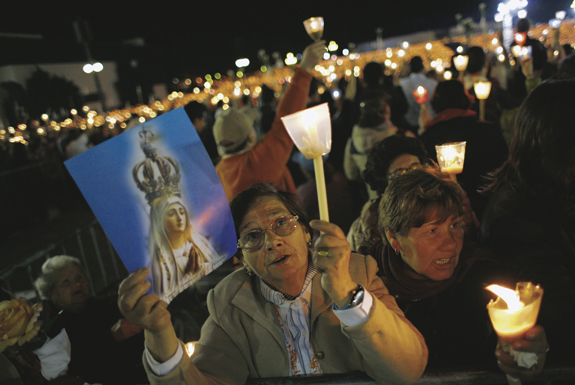by Francis X. Rocca

SOTTO IL MONTE GIOVANNI XXIII, Italy (CNS) – The feast of Our Lady of Fatima, May 13, is the occasion every year for millions of devotees to celebrate the apparition of Mary to three Portuguese peasant children in 1917 and to meditate on her call for repentance and conversion by the modern world.
For a much smaller but highly dedicated group of people, the anniversary of the first apparition is also an occasion for exploring their belief that, 95 years later, the Vatican is still hiding a portion of Mary’s revelations.
The controversy is associated in a particular way with the pontificate of Blessed John XXIII, because one of the Fatima visionaries, Sister Lucia dos Santos, committed the so-called “Third Secret” to writing, with instructions that the pope should read it in the year 1960. Blessed John, who was pope from 1958 to 1963, declined to reveal the secret, which was published by the Vatican only in 2000.
The official version of the secret comes with a Vatican commentary interpreting it as an allegory of the Catholic Church’s past struggles with 20th-century ideologies and characterizing its description of a “bishop dressed in white” shot down amid the rubble of a ruined city as a prophecy of the 1981 assassination attempt on Blessed John Paul II.
But some argue that the long-suppressed document must contain something even more disturbing, perhaps a prophecy of what they call the “great apostasy”: the modernizing changes that followed the Second Vatican Council (1962-65), which was called by Blessed John.
One man with whom such skeptics would very much like to talk is Archbishop Loris F. Capovilla, Blessed John’s personal secretary, who was present when the pope read the secret for the first time.
Speaking to Catholic News Service, Archbishop Capovilla, now 96, dismisses reports that he told an Italian writer in 2006 that part of the secret remains unpublished. He says that he noticed no discrepancy between the published version and the original.
Yet he qualifies his statement with a rare admission of doubt about his own remarkable memory. “I remember a bit,” he says, “but you will understand, after so many years I wouldn’t know how to reconstruct (the secret) fully.”
Nor does he rule out the presence of such a document elsewhere in the archives of the Vatican’s Congregation for the Doctrine of the Faith, often referred to as “the Holy Office.”
“At the Holy Office there must be a kilometer of paper regarding Fatima,” the archbishop says. “I don’t deny that there may be something else, but I don’t know it.”
When he was prefect of the doctrinal congregation, Pope Benedict XVI wrote the Vatican’s commentary on the secret and insisted that what was published in 2000 was everything. In a book marking the 90th anniversary of the Fatima apparitions, he said publishing the text “was a time of light, not only because the message could be known by all, but also because it unveiled the truth amid the confused framework of apocalyptic interpretations and speculation.”
He said he had written the commentary “after having prayed intensely and meditated deeply on the authentic words of the third part of the secret of Fatima, contained on sheets written by Sister Lucia.”
Archbishop Capovilla does not disguise his reservations about the cult of Fatima, not least, he says, because it was “sometimes exploited a bit for political ends.”
During the Cold War, many interpreted the Virgin’s prophecy that Russia would “convert” as foretelling the fall of the Soviet Union. But Archbishop Capovilla says he considered those words to mean merely that Russia would embrace Christianity, which he suggests did not exclude the survival of communism.
“I have known people in perfectly good faith who were communists, but they weren’t atheists,” he says.
The archbishop’s reservations about Fatima extend more generally to the phenomenon of Marian devotion.
“A cloistered nun who has visions – here we underscore one aspect of the Christian life,” he says.
Amid the enthusiasm for ecumenism that animated Blessed John’s papacy and the Second Vatican Council, he recalls, “it was concluded, as far as Marian devotion was concerned, that perhaps it would not be appreciated by the Protestants.”
An excessive focus on Marian devotion also runs contrary to the express wishes of Mary herself, he says.
Imagining himself receiving an apparition of Mary, Archbishop Capovilla says he would tell her: “Lady, you were present at the wedding at Cana; you said words that remain eternal, ‘Do what Jesus tells you.’ You come now to tell me to convert, to do penance. But he already said all of this; it’s in the holy Gospel.”
He adds that “all of Christianity – all – for me, for the Protestants, for the Orthodox, is summed up in these words: Convert, recognize your condition as little creatures and believe in the Gospel, put it into practice, live it.”
“Having said this,” the archbishop says, “it seems to me that is everything.”
